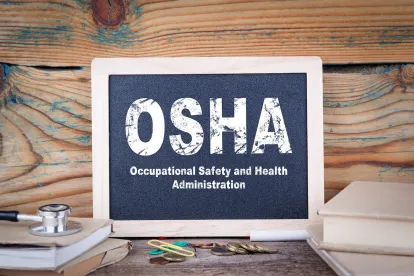As we previously reported, last week President Biden directed the Secretary of Labor to issue revised guidance to employers on workplace safety during the COVID-19 pandemic. In response to that directive, OSHA issued what the DOL described as “stronger” worker safety guidance to advise employers during the COVID-19 pandemic.
OSHA’s newest guidance, titled “Protecting Workers: Guidance on Mitigating and Preventing the Spread of COVID-19 in the Workplace”, is also only advisory. The guidance imposes no new legal obligations on employers, though it outlines existing mandatory safety and health standards. The DOL’s news release announcing the new guidance, as well as the guidance itself, also reminds employers of their responsibility under the Occupational Safety and Health Act of 1970 to provide employees with a safe and healthful workplace. Below we highlight the key guidelines for employers.
COVID-19 Prevention Program
The OSHA guidelines state that the most effective way to mitigate the spread of COVID-19 at work is for employers to implement a prevention program including numerous elements:
-
Assigning a workplace coordinator, who acts on the employer’s behalf and is responsible for COVID-19 issues.
-
Identifying where and how workers might be exposed to COVID-19 at work. OSHA recommends completing a hazard assessment and involving workers in the assessment.
-
Identifying measures that will limit the spread of COVID-19 in the workplace. OSHA suggests that employers should prioritize implementing the following measures to mitigate against the risk of infection in the workplace:
-
Physical distancing: OSHA’s guidelines note that the best way to protect workers is to have workers stay far enough away from other individuals so that they are not breathing in particles produced by an infected person, which is generally at least 6 feet away (though this is never a guarantee of safety). The guidelines encourage implementing flexible worksites and hours, and implementing flexible meeting options to limit the number of people in one place at any given time. Employers can also alter workspaces to help workers and customers maintain physical space, such as by using signs or other visual cues to remind people to maintain 6 feet of distance.
-
Barriers: If employers utilize barriers where physical distancing cannot be maintained, the guidelines recommend using barriers which block face-to-face pathways between individuals. The guidelines remind employers that barriers do not replace the need for physical distancing.
-
Face coverings: The guidelines suggest employers provide workers with face coverings at no cost. The guidelines remind employers they must discuss reasonable accommodations with any workers who cannot wear certain types of face coverings due to a disability. Employers might also require non-workers who visit the workplace to wear face coverings.
-
Ventilation: OSHA’s guidelines discuss the CDC’s and the American Society of Heating and Air-Conditioning Engineers’ guidance regarding improving ventilation and building operations during the pandemic. The guidelines suggest increasing ventilation rates and opening windows and doors where possible.
-
PPE: The guidelines state that when the above measures regarding physical distancing, face coverings, and ventilation cannot be implemented or do not protect workers fully, OSHA standards require employers to provide PPE to supplement these controls. Workers should determine what PPE is necessary and provide it, in accordance with relevant OSHA standards and other industry-specific guidance.
-
Hygiene supplies: To ensure workers have supplies to practice good hygiene, employers can provide tissues and no-touch trash bins as well as soap and warm water and time for employees to properly and frequently wash their hands.
-
Cleaning and disinfecting: OSHA recommends employers follow the CDC’s cleaning and disinfecting guidance to implement a plan for regular cleanings. Additionally, employers can avoid the sharing of objects or tools between workers, and clean any shared objects or tools.
-
-
Considering protections for workers at higher risk for severe illness through supportive policies and practices. OSHA’s updated guidance recommends that employers consider reasonable modifications for high-risk workers, such as older adults or those with serious underlying medical conditions, who can work from home or who can work in less densely-occupied, better-ventilated spaces.
-
Establishing a system for communicating effectively with workers and in a language they understand. Employers should ask workers to report COVID-19 symptoms, exposures, and workplace hazards without fear of retaliation. The guidelines also advise employers to communicate to workers all policies and procedures implemented for responding to sick and exposed workers in the workplace, and that this communication be in a language employees understand and in a manner accessible to individuals with disabilities.
-
Educating and training workers on COVID-19 policies. In addition to the prior measure, the guidelines advise that communications of workplace policies should include basic facts about COVID-19, such as about its spread and about physical distancing, and about workplace procedures implemented to protect workers.
-
Instructing workers who are infected or potentially infected to stay home and isolate or quarantine. OSHA states that it disfavors policies that encourage workers to come to work when they are sick or have been exposed. The OSHA guidelines direct employers to the CDC guidance regarding quarantine protocols, which recommends a 14-day quarantine.
-
Minimizing the negative impact of quarantine and isolation on workers. OSHA recommends allowing workers to telework, work in an isolated area, or use paid sick leave, such as the leave provided through the Families First Coronavirus Response Act.
-
Isolating workers who show symptoms at work. OSHA recommends separating and sending home workers who show symptoms while at work, and encouraging those workers to seek medical attention. Such workers should isolate until they meet CDC guidelines for exiting isolation. The guidelines also remind employers that under the Americans with Disabilities Act, employers are permitted to require a doctor’s note to verify workers are healthy enough to return to work; however, given the potential delays in seeking treatment and demands on the healthcare system, employers should be aware that requiring a COVID-19 test result or a healthcare provider’s note may delay workers’ return to work.
-
Performing enhanced cleaning and disinfection after people with suspected or confirmed COVID-19 have been in the facility. OSHA recommends following the CDC guidelines regarding cleaning and disinfecting the workplace if someone who has been in the workplace has or is suspected to have COVID-19. The CDC guidelines include opening outside doors and windows, waiting as long as practical before cleaning, and using appropriate disinfectants for use against COVID-19.
-
Providing guidance on screening and testing. OSHA encourages employers to follow state and local guidelines for screening and testing in the workplace.
-
Recording and reporting COVID-19 infections and deaths. The updated guidance reiterates prior guidance that employers must report work-related deaths and hospitalizations due to COVID-19 and employers subject to Form 300 logs must record work-related COVID-19 cases where the case is (1) a confirmed case of COVID-19; (2) work-related; and (3) involves one or more of the recording criteria under 29 CFR 1904.7. In addition to this requirement, the new guidance also states that employers “should” report outbreaks to health departments as required, and should support local health departments’ contact tracing efforts.
-
Implementing protections from retaliation and setting up an anonymous process for workers to voice concerns about COVID-19-related hazards. The guidelines point out that discriminating or retaliating against an employee for reporting unsafe working conditions or an infection or exposure to COVID-19 to an employer or OSHA is a violation of the OSH Act. To that end, the guidelines recommend ensuring workers know that they have a right to a safe and healthful workplace, that they are aware of workplace contacts regarding health and safety, and that they have a right to raise workplace health and safety concerns without fear of retaliation.
-
Guidance on Vaccination. The latest guidelines recommend making a vaccination series available at no cost to employees and caution employers to not implement measures that would single-out employees who are not vaccinated, for example only requiring unvaccinated employees to wear a mask.
The guidelines remind employers that all of OSHA’s already-existing standards regarding protecting workers from infection remain in place, such as requirements for PPE, respiratory protection, sanitation, protection from blood borne pathogens, and employee access to medical and exposure records.
OSHA notes that it will update its guidance “to reflect developments in science, best practices, and standards.” And, according to a Bloomberg Law Report, Ann Rosenthal, a senior advisor to OSHA, stated that OSHA will streamline the process for issuing employer citations related to COVID-19 so that they are issued more quickly. We will continue to monitor for any updates.





 />i
/>i


